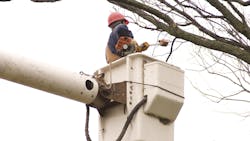Safety Often Happens Last in the Vegetation Management Industry
Safety should, and indeed, must be the number one value at any successful organization, but making this philosophy a reality involves a lot more than just whizzy gadgets and catchy slogans. So, what can be done to help keep safety under the spotlight?
Return to Basics
Oftentimes the root cause behind any stagnant safety program isn’t a lack of new ideas or initiatives, but a failure to recognize and address the tried-and-true elements of occupational safety. Never assume that your team “already knows” the difference between lagging and leading indicators, is familiar with the Heinrich incident pyramid or is aware of the inherent danger of UVM work.
Prioritize incident factors based upon probability and severity of risk, placing greater emphasis on those that are more probable and could cause the most harm. Yes, new technologies and ideas can be exciting and can help reinvigorate the team. Older, more proven methods, however, always have the upper hand when it comes to being effective because they’ve been around longer, they’ve been tested and have been more fully explored.
Define Situational Awareness
Situational awareness is mentioned a lot, but seldom defined. Before beginning to inform your team yet again to “maintain situational awareness,” provide a useful definition. Situational awareness is defined as: the perception of environmental elements and events with respect to time or space, the comprehension of their meaning, and the projection of their future status, according to Micah Endsley in Designing for Situation Awareness. It’s each of these components together that make situational awareness an important but often elusive concept in any situation.
One form of training that can help increase the situational awareness skills of a team is known as Kim's Game (Keep in Mind game). The participants are given one minute to view items on a tray before they are covered up or taken away. The participants individually list the items that they saw, with the person giving the most correct answers deemed the winner. Kim’s game helps to emphasize how limited human memory is, with most people only being able to memorize about three to four, which is an important consideration at any job site.
Ensure Psychological Safety
In psychologically safe teams, team members feel accepted, respected and are willing to say what’s on their mind. If we want our teams to say something when they see something, we must be fully committed to their psychological safety and be willing to listen to all voices and opinions whenever they surface. This is a vital component to engaging the team and getting them involved in identifying leading indicators.
Deliver Your Message Using Story
Use strong narratives to help carry the weight of your data and statistics. Facts are useful but can begin to ring hollow if they’re the only information being relayed to the team. Search for real-life examples that involve vivid imagery, and don’t be afraid to get personal to help strike an emotional chord with your audience. Above all, make sure to practice your story in advance of telling it to your audience. It doesn’t have to be scripted (in fact, it’s probably better if it isn’t), but be sure you have at least practiced it once or twice before delivering it in a safety setting.
To Change Behavior, Change the Environment
We like to believe that simply giving someone information is enough to bring about real change. Unfortunately, saying something like “If you do this, you might get hurt” just doesn’t always cut it (by the way, showing gruesome pictures doesn’t work either). However, introducing a change to one’s environment can have a much larger effect. The best part about this concept is that it doesn’t even need to be a big change or intervention. Something as simple as a change in schedule, a change in personal protective equipment or a minor alteration of a work method can have a big result.
Make Safety Social
Job briefings, tailboard trainings and team stretches can all be made more compelling and more memorable by performing these activities together as a team. Make it a policy to praise in public, and coach in private, and never miss a chance to get your team together in a group setting whenever possible.
To prevent safety from becoming a mere afterthought, it’s important to return to the basics of leading and lagging indicators and the tried-and-true components of occupational safety. Even if you are sure that your team is aware of conventional safety topics, it never hurts to recover familiar ground.
Bill Spencer is Safety Manager for CNUC.
About the Author
Bill Spencer
Bill Spencer is Safety Manager for CNUC.
